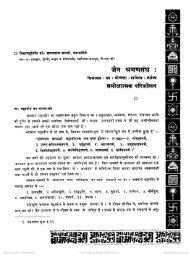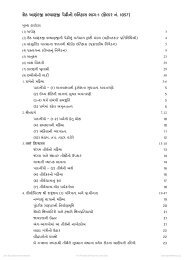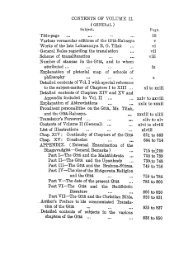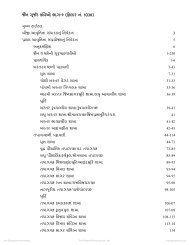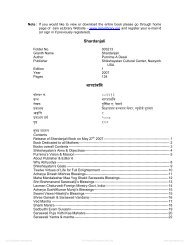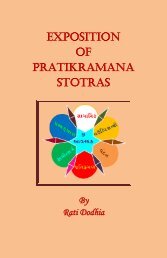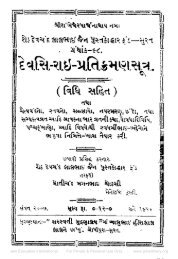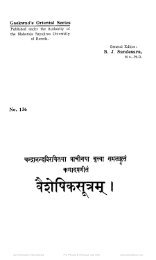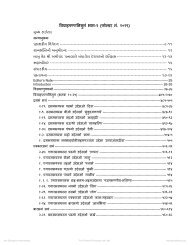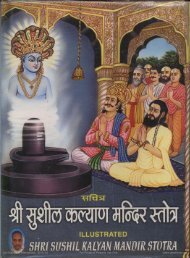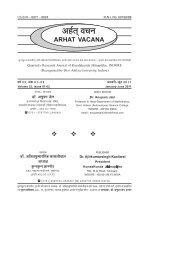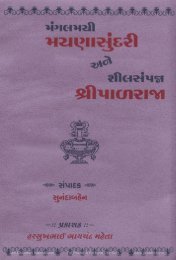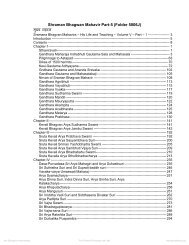Chovisi & 63 Shalaka Purusha - Jain Library
Chovisi & 63 Shalaka Purusha - Jain Library
Chovisi & 63 Shalaka Purusha - Jain Library
Create successful ePaper yourself
Turn your PDF publications into a flip-book with our unique Google optimized e-Paper software.
<strong>Chovisi</strong> &<br />
<strong>63</strong> <strong>Shalaka</strong> <strong>Purusha</strong><br />
(314) 837-8101<br />
July 6, 2011
Contents<br />
01. Introduction<br />
02. Universe -- Figure<br />
03. Three Dimensional Universe<br />
04. Innumerable Concentric Islands and Oceans-- Figure<br />
05. Two & Half Islands and Fifteen Continents -- Figure<br />
06. Jambu Island – Figure<br />
07. <strong>Chovisi</strong> and <strong>63</strong> <strong>Shalaka</strong> <strong>Purusha</strong> (Bharat & Eravat Continents) -- Figure<br />
08. <strong>Chovisi</strong> and <strong>Shalaka</strong> <strong>Purusha</strong>, <strong>Chovisi</strong> and Six Aras<br />
09. Sixty Three <strong>Shalaka</strong> <strong>Purusha</strong><br />
10. Chakravarti<br />
11. Baldeva, Vasudeva, and Prativasudeva<br />
12. Dreams to Mother, Tirthankers and Other Kevalis, Liberation, and Great Event<br />
13. List of Sixty <strong>Shalaka</strong> <strong>Purusha</strong><br />
14. List of Sixty Three <strong>Shalaka</strong> <strong>Purusha</strong><br />
15. Attributes of Tirthankers (Atishaya)<br />
16. Lord Mahavir
Introduction<br />
Dear Sadharmik:<br />
Jai Jinendra.<br />
Welcome to <strong>Chovisi</strong> and <strong>63</strong> <strong>Shalaka</strong> <strong>Purusha</strong>, a visual step-by-step presentation of the<br />
<strong>Chovisi</strong> and <strong>63</strong> <strong>Shalaka</strong> <strong>Purusha</strong>.<br />
This presentation is graphic based and is intended to serve as an important aid to the viewer.<br />
I welcome your feedback on your experience with this presentation and suggestions<br />
on future edition improvements.<br />
Sincerely,<br />
Bharat K. Shah<br />
(314) 837-8101<br />
E-mail bbsshah@yahoo.com<br />
Page 1
14<br />
13<br />
12<br />
11<br />
10<br />
9<br />
8<br />
RAJJU<br />
UNIVERSE<br />
11 12<br />
9 10<br />
8<br />
7<br />
6<br />
5<br />
K3<br />
+<br />
+ +<br />
+ + +<br />
+ +<br />
+<br />
K2<br />
3 4<br />
1 2<br />
K1<br />
Green - Celestial World (Urdhvalok)<br />
Red - Middle World (Tirchhalok)<br />
Black - Lower World (Adholok)<br />
Alok<br />
7<br />
Alok<br />
Alok<br />
1<br />
6<br />
2<br />
5<br />
4<br />
3<br />
4<br />
Alok<br />
Figure 1<br />
3<br />
5<br />
2<br />
1<br />
6<br />
7<br />
1 2 3 4 5 6 7 8<br />
RAJJU<br />
Page 2
Three Dimensional Universe<br />
If you throw a Bhar from the space above you, the distance it travels in 6 months, 6<br />
days, 6 Prahar, and 6 Ghadis is called one Rajju.<br />
Universe Height = 14 Rajju<br />
Universe Width = 7 Rajju<br />
Universe Volume = 343 Cubic Rajju<br />
One Bhar = 38,112,970 * 40 pounds<br />
One Prahar = 3 hours<br />
One Ghadi = 24 Minutes<br />
Lower World<br />
The Lower world is the home of infernal beings (narki) as well as of certain Devas.<br />
This region consists of seven tiers, each darker than the one above.<br />
Middle World<br />
The middle world consists of innumerable concentric islands and seas, with Jambu<br />
island in the center.<br />
This is the abode of humans and animals.<br />
Celestial World<br />
This is the abode of heavenly beings.<br />
Siddha Sheela<br />
This crescent-shaped region is the permanent abode of the liberated souls.<br />
Loka and Aloka<br />
The <strong>Jain</strong>a universe is conceived as three-dimensional structure. It is called Loka.<br />
The empty space in which no world, atmosphere, motion, or anything else is found<br />
is called Aloka.<br />
Page 3
Innumerable Concentric Islands and Seas<br />
1 3 5 7 9 11 13 15 17 …………………....<br />
The middle world consists of innumerable concentric islands and oceans, with Jambu island<br />
in the center. The last ocean is called Swayambhurman, beyond which Loka ends.<br />
Page 4
Two & Half Islands and Fifteen Continents<br />
N<br />
Half-Puskarvara Island<br />
W<br />
Eravat<br />
Eravat<br />
Black Ocean<br />
~<br />
~ ~~<br />
~ ~ ~ ~<br />
~ ~ ~<br />
Dhataki Island ~ ~ ~<br />
~ Eravat<br />
Eravat ~ ~ ~<br />
~ ~<br />
~ ~<br />
~ ~<br />
~ ~<br />
Lavan Ocean<br />
Jambu ~ ~~<br />
~<br />
~ ~ ~ ~ ~<br />
~<br />
~ ~<br />
~ ~ ~ ~ ~ ~<br />
~ ~ ~ ~<br />
~ ~<br />
~ ~ ~<br />
~ ~ ~<br />
~ ~ ~ ~<br />
~ ~<br />
~ ~<br />
~ ~<br />
Bharat ~ ~<br />
~<br />
~<br />
~ ~<br />
Eravat<br />
Maha Videh Maha Videh Maha Videh Maha Videh Maha Videh<br />
~ ~ ~ ~<br />
Bharat<br />
~ ~<br />
Bharat<br />
~ ~<br />
~ ~<br />
~<br />
~ ~~ ~ ~ ~<br />
Bharat<br />
~<br />
~<br />
~ ~<br />
~ ~ ~ ~<br />
Bharat<br />
E<br />
Human population is only in Jambu, Dhataki, and one-half of Puskarvara Islands.<br />
Liberation of the soul is possible only in 15 continents of Bharat, Eravat, and Mahavideh.<br />
One of each is on Jambu Island, two of each (east-west) is on Dhataki Island, and Half-<br />
Puskarvara Island, respectively.<br />
All together there are fifteen continents: five Bharats, five Eravats, and five Mahavidehs.<br />
S<br />
Page 5
Jambu Island<br />
Eravat<br />
Maha<br />
Videh<br />
Bharat<br />
Page 6
<strong>Chovisi</strong> and <strong>63</strong> <strong>Shalaka</strong> Purush (Bharat and Eravat Continents)<br />
Utsarpini<br />
Starts<br />
6 5 4 3 2 1<br />
4KS 3KS . 2KS 1KS - 21,000 YRS 21,000 YRS<br />
42,000 YRS<br />
1 2 3 4 5 6<br />
Avasarpini<br />
starts<br />
R R R R R<br />
24 12 9 9 9 Prati Other<br />
Tirthankers Chakravartis Baldevas Vasudevas Vasudevas People<br />
14D 14D 3D 7D<br />
R<br />
R<br />
R<br />
R<br />
12G-13G<br />
Sheds four GHATI karmas.<br />
1. Knowledge Obscuring (Jnanavaraniya) 3. Deluding (Mohaniya)<br />
2. Perception Obscuring (Darsanavaraniya) 4. Obstructive (Antaraya)<br />
13G<br />
ARIHANT, KEVALI, BHAGAVAN, OMNISCIENT<br />
TIRTHANKERS<br />
Tirthanker nama karma is manifested.<br />
Have 34 Atishayo.<br />
All five Kalyanaks are celebrated.<br />
Live many years in Kevali state.<br />
Preach the religion.<br />
Establish the mobile Tirth of Sadhus, Sadhavis,<br />
Shravaks, and Shravikas.<br />
OTHER KEVALIS<br />
No specific nama karma is manifested.<br />
May have 1 or 2 Atishayo.<br />
Two or three Kalyanaks are celebrated.<br />
May or may not live many years in Kevali state.<br />
May preach the religion.<br />
13G<br />
Sheds four AGHATI karmas.<br />
1. Life Span (Ayushya) 3. Status Determining (Gotra)<br />
2. Body Making (Nama) 4. Feeling Producing (Vedaniya)<br />
14G<br />
SIDDHA, BHAGAVAN, (LORD)<br />
KS<br />
R<br />
= KotaKoti Sagaropam<br />
= Reincarnation<br />
= Three years eight month and 15 days<br />
before the next Ara (Nirvana days of the<br />
1st and the last Tirthankers).<br />
= 2,526 years have been passed in the<br />
fifth Ara (May 2000).<br />
Page 7
<strong>Chovisi</strong> and Salaka <strong>Purusha</strong><br />
In Sanskrit, <strong>Chovisi</strong> means 24, <strong>Shalaka</strong> means a pious or best person who is destined to be liberated,<br />
and <strong>Purusha</strong> means man. Tirthaners are <strong>Shalaka</strong> <strong>Purusha</strong>s. Even though they are referred<br />
to as <strong>Shalaka</strong> <strong>Purusha</strong>, woman also can be a <strong>Shalaka</strong> <strong>Purusha</strong>. In a given time-frame, a total of<br />
twenty-four Tirthankers one after the another are born and therefore it is called a <strong>Chovisi</strong>.<br />
In <strong>Jain</strong>ism, the time cycle is measured in KotaKoti Sagaropam.<br />
Karod --- 10,000,000<br />
KotaKoti --- Karod x Karod<br />
Palyopam --- Specified in innumerable time units. However, it can be explained by<br />
an assumed illustration:<br />
To fill up a cubic box ( 8 miles long, wide, and deep) with the smallest<br />
possible pieces of a new born baby's hair; one Palyopam would be equal<br />
to time taken to empty the cubic box by taking out one piece of hair every<br />
100 years.<br />
Sagaropam --- 10 KotaKoti Palyopam<br />
<strong>Chovisi</strong> --- 10 KotaKoti Sagaropam<br />
One Time Cycle --- 20 KotaKoti Sagaropam ( two <strong>Chovisi</strong>)<br />
<strong>Chovisi</strong> and Six Aras<br />
The time cycle for both Bharat and Eravat is 20 KotaKoti Sagaropam.<br />
This time cycle is divided in two equal phases called ascending phase (Utsarpini) and descending phase<br />
(Avasarpini). Both phases are also called <strong>Chovisi</strong> because 24 Tirthankers are born in each of the phases.<br />
The <strong>Chovisi</strong> is divided into six periods called Aras, which are unequal on time basis.<br />
As time passes from the 1 st Ara through the 6 th Ara of the Avasarpini, the happiness, life spans, religious<br />
faith, etc. go from the best conditions to the worst. The Utsarpini and the Avasarpini are mirror images<br />
of each other. Therefore as the time passes from the 1 st Ara through the 6 th Ara of the Utsarpini the<br />
happiness, life spans, religious faith, etc. go from the worst conditions to the best. When the Avasarpini<br />
phase ends the Utsarpini phase begins. These time cycles continue forever. The chart on the next page<br />
shows the time period of each Ara.<br />
We are living in the Bharat continent of the Jambu Island. The current time period is the 5 th Ara of the<br />
Avasarpini. On May 2000 two thousand five hundred and twenty-six years have been passed in the fifth<br />
Ara.<br />
Liberation of the soul is possible all the time in the Mahavidehs. But in Bharats and the Eravats it is only<br />
possible in the 4 th Ara of the Avasarpini and the 3 rd Ara of the Utsarpini phase.<br />
( Avasarpini - Descending Cycle) ( Utsarpini - Ascending Cycle)<br />
1 st Ara = 4 KotaKoti Sagaropam 1 st Ara = 21,000 Years<br />
2 nd Ara = 3 KotaKoti Sagaropam 2 nd Ara = 21,000 Years<br />
3 rd Ara = 2 KotaKoti Sagaropam 3 rd Ara = 1 KotaKoti Sagaropam less 42,000 Years<br />
4 th Ara = 1 KotaKoti Sagaropam less 42,000 Years 4 th Ara = 2 KotaKoti Sagaropam<br />
5 th Ara = 21,000 Years 5 th Ara = 3 KotaKoti Sagaropam<br />
6 th Ara = 21,000 Years 6 th Ara = 4 KotaKoti Sagaropam<br />
Page 8
Sixty Three <strong>Shalaka</strong> <strong>Purusha</strong>s<br />
Sixty-three Salaka <strong>Purusha</strong>s are born in the 4 th Ara of the Avasarpini and the 3 rd Ara of the Utsarpini.<br />
They are as follows:<br />
24 Tirthankers,<br />
12 Chakravartis,<br />
9 Baldevas,<br />
9 Vasudevas, and<br />
9 Prativasudevas.<br />
Besides the 24 Tirthankers, other well-known <strong>Shalaka</strong> <strong>Purusha</strong>s' names of the current <strong>Chovisi</strong> include:<br />
Bharat Chakravarti (1 st Chakravarti), Shree Ram (8 th Baldeva), Lakhman (8 th Vasudeva),<br />
Ravan (8 th Prativasudeva), and Shree Krishna (9 th Vasudeva).<br />
Page 9
Chakravarti<br />
Twelve Chakravartis are born in each ascending and descending time cycle in Bharat and Earvat<br />
continents of Jambu Island, Dhataki Island, and half-Pushkarvara Island.<br />
Chakravarti is considered the greatest and strongest king of the continent.<br />
He is called a Chakravarti because a powerful one-sense living being called “Chakra” is born in his<br />
kingdom to serve him. With the help of the Chakra, he conquers all six parts of the continent.<br />
Chakravarti has seven powerful human beings and seven one-sense living beings including the<br />
“Chakra” in his kingdom to serve him. In addition, because of his good karmas many Devas serve<br />
him.<br />
Bharat Chakravarti was the 1st Chakravarti of this descending time cycle of the Bharat continent of<br />
Jambu Island. He was the son of the 1 st Tirthanker Rushabhadev of the current time cycle of the<br />
Bharat continent of Jambu Island.<br />
Chakravarti is considered an unbeatable king, but Bharat Chakravarti has almost lost a war against<br />
his brother Bahubali. Instead of winning the war, Bahubali opted to renounce the worldly life on<br />
the battleground and became a monk.<br />
Chakravarti, who renounces the worldly life and becomes a monk, may attain liberation or is born<br />
in heaven in his next birth.<br />
Tirthanker’s mother dreams 14 auspicious dreams at the time of conception. Chakravarti’s mother<br />
also dreams 14 auspicious dreams at the time of conception.<br />
However, Chakravarti’s mother’s dreams are not as bright as Tirthanker mother’s dreams.<br />
The followings are the twelve Chakravartis of the current descending time cycle of the Bharat<br />
continent of Jambu Island.<br />
Name<br />
After death/Nirvana<br />
1. Bharat Liberated<br />
2. Sagar Liberated<br />
3. Madhav Heaven<br />
4. Sanat Kumar Heaven<br />
5. Santinath Liberated<br />
6. Kunthunath Liberated<br />
7. Aarnath Liberated<br />
8. Sambhum 7 th Hell<br />
9 Mahapadm Liberated<br />
10. Harishan Liberated<br />
11. Jayshan Liberated<br />
12. Brahmdatt 7 th Hell<br />
6 Parts of Bharat Continent<br />
3<br />
2<br />
4 5<br />
1<br />
6<br />
Page 10
Vasudeva, Baldeva, and Prativasudeva<br />
Nine Baldevas, nine Vasudevas, and nine Prativasudevas are born in each ascending and descending<br />
time cycle in Bharat and Earvat continents of Jambu Island, Dhataki Island, and half-Pushkarvara Island.<br />
Baldevas, Vasudevas, and Prativasudevas are born as princes.<br />
Baldeva and Vasudeva are always born as brothers, Baldeva being the eldest brother.<br />
Prativasudeva is always an enemy of Baldeva and Vasudeva.<br />
Baldeva is very serene person. He doesn’t like to wage a war. He goes on the war only when all other<br />
options don’t work. There is a high degree of attachment between Baldeva and Vasudeva.<br />
Vasudeva is considered the strongest person of the continent. He conquers three parts (1, 2, & 6) of the continent<br />
From the Prativasudevas.<br />
Prativasudeva is an angry man with ego and jealousy.<br />
Prativasudeva always wage a war against Baldeva and Vasudeva. Vasudeva kills Prativasudeva in the war.<br />
Baldeva renounces the worldly life and becomes a monk. He may attain liberation or is born<br />
in heaven. Vasudeva and Prativasudeva don’t renounce the worldly life therefore they have to take few more<br />
births before they attain the ultimate liberation.<br />
Vasudeva’s mother dreams 7 auspicious dreams at the time of conception.<br />
Baldeva’s mother dreams 3 auspicious dreams at the time of conception.<br />
Prativasudeva’s mother doesn’t dream any auspicious dreams at the time of conception.<br />
Ram, Lakshman, and Ravan are the 8 th Baldeva, Vasudeva, and Prativasudeva of the current time<br />
cycle of the Bharat continent of Jambu Island, respectively.<br />
Balbhadra, Shree Krishna, and Jarasangh are the 9 th Baldeva, Vasudeva, and Prativasudeva of the<br />
current time cycle of the Bharat continent of Jambu Island, respectively.<br />
The followings are the nine Baldevas, nineVasudevas, and nine Prativasudevas of the current descending time<br />
cycle of the Bharat continent of Jambu Island.<br />
Baldeva Destiny Vasudeva Prativasudeva<br />
1 Achal Liberated Tripusht (Mahavir’s soul) Sugri.<br />
2. Vijay Liberated Dvipusht Tarak<br />
3. Bhadra Liberated Swayambhu Merak<br />
4. Suprabh Liberated Purushotam Madhukit<br />
5. Sudarsan Liberated Purushsinh Nasumbh<br />
6. Aanand Liberated Purush Pundarik Bal<br />
7. Nandan Liberated Datt Prahlad<br />
8. Ram Liberated Lakshman Ravan<br />
9 Balbhadra Heaven Krishna Jarasangh<br />
Bharat Continent<br />
Page 11<br />
3<br />
2<br />
4 5<br />
1<br />
6
Mother's Dreams<br />
At the time of conception, Tirthanker's mother, Chakravarti's mother, Baldeva's mother, and Vasudeva's mother<br />
have 14 bright dreams, 14 dim dreams, 3 very dim dreams, and 7 dimmer dreams respectively.<br />
Prativasudeva's mother does not have any dreams.<br />
Tirthankers and Other Kevalis<br />
There are 14 stages of spiritual development for liberation. Theses stages are called Gunasthans.<br />
When a person progresses towards liberation, he/she gradually progresses one by one Gunasthan.<br />
When the person sheds four Ghati Karmas, he/she becomes omniscient and enters into the 13 th Gunasthan.<br />
The omniscient person is called Arihant, Kevali, or Bhagavan. There are many differences between<br />
Tirthanker Kevalis and other Kevalis. One of the main differences is that Tirthanker Kevalis establish<br />
the mobile Tirth of sadhus, sadhvis, shravaks, and shravikas. Other Kevalis do not establish the Tirth.<br />
Liberation of <strong>Shalaka</strong> <strong>Purusha</strong>s<br />
when the person sheds the remaining four Aghati Karmas, he/she attains liberation. Before ultimate<br />
Liberation, they have to progress from 13 th to 14 th Gunasthan.<br />
Tirthankers teach, guide, and show others the path of liberation and attain liberation themselves.<br />
Chakravartis and Baldevas who renounce the worldly things may attain liberation or will reincarnate.<br />
Vasudevas and Prativasudevas are engulfed in the worldly things, therefore they cannot attain liberation<br />
and will reincarnate.<br />
Lord Rushabhadev attained liberation at the beginning of the 4 th Ara and Lord Mahavira attained liberation<br />
at the end of the 4 th Ara. The time period between the 1st Tirthanker attained liberation and the last<br />
Tirthanker attained liberation is a constant time-frame for all <strong>Chovisi</strong>s. It is one KotaKoti Sagaropam<br />
minus 42,000 years.<br />
The chart shows the liberation of humans only in Bharats and Eravats continents. The soul born as animal,<br />
celestial, and hellish beings cannot attain liberation. They must be born as human being to attain liberation.<br />
Great Event<br />
After learning about the <strong>63</strong> Shalak <strong>Purusha</strong>s from Sadhaviji Yakini, Pujya Shree Acharya Haribhadrasuri<br />
was very much impressed by <strong>Jain</strong>ism. He renounced his faith from Hindu religion and embraced <strong>Jain</strong>ism.<br />
He has written 1,444 books covering a wide spectrum of different subjects of <strong>Jain</strong>ism.<br />
Page 12
1. Rushabhdev<br />
2. Bharat<br />
3. Ajitnath<br />
4. Sagar<br />
5. Sambhavnath<br />
6. Abhinandan<br />
7. Sumatinath<br />
8. Padmprabhu<br />
9. Suparshwanath<br />
10. Chandraprabhu<br />
11. Suvudhinath<br />
12. Shitalnath<br />
13. Sreyansanath<br />
14. Aswagriv<br />
15. Achal<br />
16. Tripushta<br />
17. Vasupujya Swami<br />
18. Tarak<br />
19. Vijay<br />
20. Dvipushta<br />
21. Vimalnath<br />
22. Merak<br />
23. Bhadra<br />
24. Swayambhu<br />
25. Anantnath<br />
26. Madhukit<br />
27. Suprabha<br />
28. Purushotam<br />
29. Dharmnath<br />
30. Nasumbha<br />
31. Sudarsan<br />
32. Purushsinha<br />
33. Maghava<br />
34. SanatKumar<br />
35. Shantinath<br />
36. Kunthunath<br />
37. Aranath<br />
38. Bali<br />
39. Anand<br />
40. Purush Pundarik<br />
41. Subhum<br />
42. Prahalad<br />
43. Nandan<br />
44. Datt<br />
45. Mallinath<br />
46. Munisuvrat<br />
47. Mahapadma<br />
48. Ravan<br />
49. Ram<br />
50. Lakshman<br />
51. Naminath<br />
52. Harishen<br />
53. Jay<br />
54. Neminath<br />
55. Jarasangh<br />
56. Balbhadra<br />
57. Krishna<br />
58. Brahmdatt<br />
59. Parswanath<br />
60. Mahavir<br />
The above list contains all the <strong>Shalaka</strong> <strong>Purusha</strong> names.<br />
Can you tell, why the total is 60<br />
Page 13
1. Rushabhdev<br />
2. Bharat<br />
3. Ajitnath<br />
4. Sagar<br />
5. Sambhavnath<br />
6. Abhinandan<br />
7. Sumatinath<br />
8. Padmprabhu<br />
9. Suparshwanath<br />
10. Chandraprabhu<br />
11. Suvudhinath<br />
12. Shitalnath<br />
13. Sreyansanath<br />
14. Aswagriv<br />
15. Achal<br />
16. Tripushta<br />
17. Vasupujya Swami<br />
18. Tarak<br />
19. Vijay<br />
20. Dvipushta<br />
21. Vimalnath<br />
22. Merak<br />
23. Bhadra<br />
24. Swayambhu<br />
25. Anantnath<br />
26. Madhukit<br />
27. Suprabha<br />
28. Purushotam<br />
29. Dharmnath<br />
30. Nasumbha<br />
31. Sudarsan<br />
32. Purushsinha<br />
33. Maghava<br />
34. Sanat Kumar<br />
35. Shantinath Shantinath<br />
36. Kunthunath Kunthunath<br />
37. Aranath Aranath<br />
38. Bali<br />
39. Anand<br />
40. Purush Pundarik<br />
41. Subhum<br />
42. Prahalad<br />
43. Nandan<br />
44. Datt<br />
45. Mallinath<br />
46. Munisuvrat<br />
47. Mahapadma<br />
48. Ravan<br />
49. Ram<br />
50. Lakshman<br />
51. Naminath<br />
52. Harishen<br />
53. Jay<br />
54. Neminath<br />
55. Jarasangh<br />
56. Balbhadra<br />
57. Krishna<br />
58. Brahmdatt<br />
59. Parswanath<br />
60. Mahavir<br />
Page 14
Attributes of Tirthankars (Atishaya)<br />
Tirthankars have unique attributes known as Atishaya.<br />
Some Atishayas are birth related, some are created by heavenly Dev,<br />
and some are realized at the time of becoming omniscient.<br />
By birth, Tirthankar has the most beautiful, powerful, and proportionally<br />
built body with 1008 auspicious birth marks on his body. As he is full of<br />
compassion, his blood is white, like milk. His breath is fragrant like a lotus<br />
and his body doesn’t generate any waste. He is always disease free.<br />
He has very soothing, peaceful, serene and effective eloquent voice which<br />
can be heard from very long distances. His language can be easily understood<br />
by all – humans and animals alike. He can be seen and heard from all four<br />
directions. Everyone listens to the sermon keeping their individual animosity aside.<br />
In his vicinity the weather is always pleasant and there are no calamities for miles.<br />
The following are always present during Tirthankar’s sermon.<br />
Simhasan - A divine seat from which Tirthankar delivers sermon<br />
Bhamandal - A halo around Tirthankar’s head<br />
Chamar<br />
- Angles are waving fans (Chowries)<br />
Chhatra<br />
- A three tier divine umbrella over the head<br />
Ashok Vruksha - A tree under which Tirthankar sits<br />
(12 times in height of respective Tirthanker)<br />
Pushpavrusti - A continuous shower of fragrant flowers<br />
Dev- dundubhi - A devine announcement declaring Tirthankar’s sermon<br />
Dev-dhawani - A celestial music accompanying Tirthankar’s sermon<br />
Page 15
Lord Mahavir<br />
Mahavir was born on the 13 th day of the rising moon half of Chaitra<br />
month in 599 B.C. in the state of Bihar, India. His father name was<br />
Siddharth who was the king of Kshatriyakund. His mother name was<br />
Trishala.<br />
From the early childhood, he was found to be unusually intelligent, fearless,<br />
affectionate, and compassionate. At school, he hardly needed any instructions.<br />
He was born with three jnaan (Mati, Shruti, and Avadhi).<br />
From the childhood, he knew that worldly happiness was not ever lasting.<br />
Therefore at the age of 30, he renounced the worldly life to become a monk.<br />
He spent the next twelve and half years in deep silence and meditation to conquer<br />
his desires, feelings, and attachments. He carefully avoided harming or annoying<br />
other living beings including animals, birds, and plants.<br />
Also during this time he observed severe austerities, fasting for most of the time,<br />
moving from place to place on bare foot, and peacefully faced all types of hardships.<br />
He progressed spiritually and ultimately he shed his four destructive Karmas and<br />
attained perfect perception, perfect knowledge, perfect power, and total bliss.<br />
This realization is known as Kevaljnan (omniscience).<br />
Now Mahavir became Lord Mahavir or Bhagavan Mahavir.<br />
Lord Mahavir spent the following thirty years traveling around India preaching<br />
the eternal truth to the people which he had realized. Lord Mahavir preached that<br />
right faith, right knowledge, and right conduct together is the real path<br />
to attain the liberation.<br />
At the age of seventy two, Lord Mahavir attained liberation (Nirvan),<br />
and became Siddha.<br />
Page 16



